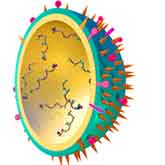Flu Pandemics in the 20th Century
 If a flu virus emerges that is either new or that has not circulated in many years, and if it is able to spread easily from person to person, it could quickly travel around the world and cause serious illness and death for millions of people. This is called a flu pandemic. The 1918 Spanish flu pandemic is the catastrophe against which all modern pandemics are measured. More than 20 million people were killed worldwide; 500,000 died in the United States alone. This virus was especially quick to kill. So far, the world has not seen a virus that severe again.
If a flu virus emerges that is either new or that has not circulated in many years, and if it is able to spread easily from person to person, it could quickly travel around the world and cause serious illness and death for millions of people. This is called a flu pandemic. The 1918 Spanish flu pandemic is the catastrophe against which all modern pandemics are measured. More than 20 million people were killed worldwide; 500,000 died in the United States alone. This virus was especially quick to kill. So far, the world has not seen a virus that severe again.
In 1957 and 1968, the Asian flu and Hong Kong flu, respectively, invaded the United States. Although hundreds of thousands of people in the United States died, the death toll for each pandemic was not as high as that for the Spanish flu. In 1976, the United States experienced a swine flu scare. When a new flu virus was first identified at Fort Dix, New Jersey, it was labeled the 'killer flu,' and health experts were afraid that it would infect people around the world. In fact, swine flu never left the Fort Dix area. Research on the virus later showed that if it had spread, it would probably have been much less deadly than the Spanish flu.
In 1997, another 'near miss' pandemic occurred when 18 people in Hong Kong became ill from a new flu virus. Six of the infected people subsequently died. Usually, flu viruses move first from chickens to pigs, and then from pigs to humans. This virus was different because it moved directly from chickens to people. The avian flu never became a pandemic, however, because it didn't easily spread from person to person. In addition, public health authorities ordered the slaughter of all live chickens in Hong Kong.
About the Author
NIH NIAID
 The National Institute of Allergy and Infectious Diseases is one of the 27 institutes and centers that make up the National Institutes of Health, an agency of the United States Department of Health and Human Services.
The National Institute of Allergy and Infectious Diseases is one of the 27 institutes and centers that make up the National Institutes of Health, an agency of the United States Department of Health and Human Services.


